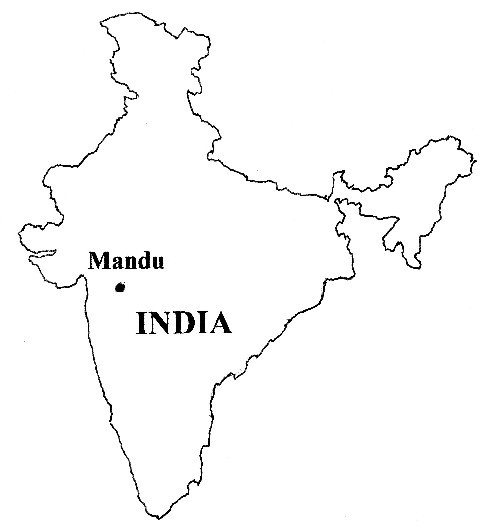
Aliqult :The two divs, a miniature painting in a (1470) copy of Amir Khusrau's Khamsah
(meaning Quintet) (manuscript from Mandu)
----------------------------------------------------
The style of the illustrations in one of the manuscripts of the Khamsah of Amir Khusrau date this copy to the end on the 15th century and to Mandu. This copy of the Khamsah was made for the ruler Ghiyas al-Din of Mandu in the 1470ties.
Mandu later called Shadiabadi (city of joy) was in those years a center of East African trade. I searched the manuscripts made or copied in the city during that period for any, even faint traces of East Africa. This is one of the two faint traces I found.
The two divs (demons) appear in the Khamsah to built a palace for Sulayman (Solomon) they perform in a day the work of a month, when finished, and having nothing to do they break it down again.
The divs now seen in the building work (in the Khamsah's illustration by Aliqult) are large, solidly build, and convey strength and energy. With spotted skins, horns, fangs, kilts and bells, like the regular demons. But he also painted detailed bone structures of the faces, focused eyes, softening hair, and moustaches, this produces the image of men, perhaps soldiers or servants stood as model. It might be that the very human, black skinned divs (demons) are the workforce of African slaves that helped build the fortress city of Mandu in the first place. (This at least is the opinion of Barbara Brend who wrote the book) (Mandu is the biggest, still existing, fortress city in the world.)
-----------------------------------------------------------------------------------------------------------------------------
In the Khamsa(h) of Amir Khusrau itself the following mentions of black people are made: Note that Amir Khusrau was living in India and wrote the book in 1298. The frequent appearing of black people (African) makes it clear that although this is a fiction book Africans (slaves) were common in society.
The king has a black guard, bitter of face and distorted of speech, with wide waist and narrow spirit, his mouth furred with rotten breath, his belly like a brazier, gaping, quarrelsome and foolish.
(Nizami's Iskandarnamah is summarized) Iskandar, already famous for his victories, turns towards Chin, and from its frontier he sends a message to the Khaqan which recalls his successes against the Zangi, against Dara of Iran and in Hindustan, and calls upon him to submit.
He (the king) discovers the lady being whipped for her late arrival at a tryst by a black and drunken muleteer.
------------------------------------------------------------------------------------------------------------------------------